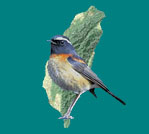 |
|
||||||||||||
|
|
|||||||||||||
 |
|
||||||||||||
|
|
|||||||||||||
|
Endemic Species White-whiskered Laughingthrush
Yellow Tit
Endemic Sub-Species
More Birds in Taiwan
|
Taiwan Partridge Arborophila crudigularis
Endemic
A smallish (2225 cm) partridge with conspicuous black-and-white face markings. Crown gray; side of head black with long white supercilium, white chin and throat extending into bold white patch below eye. The broad black half-collar is underlined by whitish and buff. Bare orbital skin dark red; back and tail olive barred with black; wings rufous with three gray bars; breast blue-gray, streaked with white on flanks. Belly white, undertail coverts whitish, barred with black. Iris, brown; bill, blackish-gray; legs, red. Female: half-collar is narrower and mixed with white. Found in central mountains and eastern slopes 7002,300 m where it is not uncommon in temperate broadleaf forests. The call is a far-reaching, repeated guru, guru, guru rising in pitch then falling back suddenly. They live in small parties gleaning the forest floor, scratching in the leaf litter for seeds, berries, seedlings, earthworms, and insects and running away quietly when disturbed. Breeding season from March to August. The nest is placed in a crevice among boulders, or hidden at the base of a tree. Clutch size; 68 eggs. The incubation period is 2021 days. Taiwan Partridge is considered Near-threatened. While formerly widespread at suitable elevation, it has been less frequently recorded in recent years. The main pressures are those on habitat, which is reduced by tree-felling, conversion to agricultural land, and possibly pesticides.
Reference: Endemic Species of Taiwan, compiled by Greenland Ecology Conservation Association of R.O.C.
|